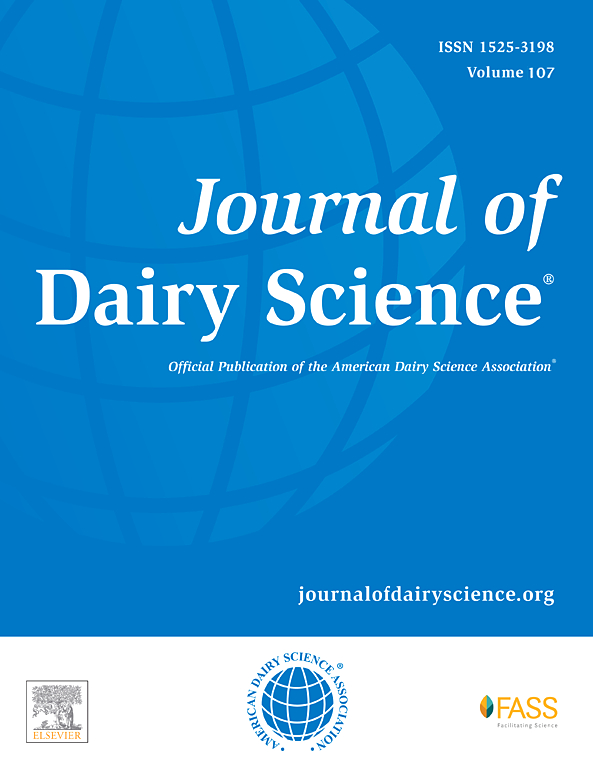Dairy farm management factors associated with clinical observations in young dairy calves sold at auction markets in Québec, Canada: A cross-sectional study
IF 3.7
1区 农林科学
Q1 AGRICULTURE, DAIRY & ANIMAL SCIENCE
引用次数: 0
Abstract
In Québec, Canada, nonreplacement calves are generally sent at a young age to auction markets to be sold for veal or dairy beef production. Various clinical observations found during the calves' journey, either at an auction market or on arrival at a calf raiser farm, have been associated with increased risk of morbidity, such as dehydration or umbilical problems. The objective of this cross-sectional study was to quantify associations between calf raising management strategies at the dairy farm level and clinical observations at auction markets during sale. For this purpose, during 8 different sale days, the 2 largest auction markets in Québec were visited, and all calves sold on those days were systematically examined. The number of clinically relevant findings (CRF) present per calf (among presence of umbilical cord, wet umbilical area, umbilical pain, umbilical swelling, persistent cervical skin fold ≥2 s, sunken eyes, eye or nasal discharge, ear drop, limb anomaly, emaciation or dirty hide) was recorded. After the sale, farm owners were contacted to answer a specific questionnaire on calf management. The total number of CRF from all sold calves from the same farm (dependent variable) was modeled using Poisson multivariable regression, with questionnaire answers as potential covariates and the number of calves sold per farm during the observation period as an offset. The questionnaire was completed during a standardized phone call and focused on farm characteristics and characteristics of calves sold, including calving management, calf care at birth, nutrition, housing, and transportation. A total of 3,656 calves from 1,349 different sellers were examined. The questionnaire information was obtained from 409 different farms representing 847 calves. The median number of calves sold per farm was 2 (range: 1–19). The umbilical cord was visually present in 376 calves (44%). Among the most commonly observed CRF, eye discharge (n = 290, 34%), umbilical swelling (n = 144, 17%), and presence of dehydration signs (persistent cervical skin fold ≥2 s [n = 111, 13%] or sunken eyes [n = 83, 9.8%]) were the most commonly reported anomalies. According to the final multivariable Poisson regression model, the incidence rate ratio (IRR) of CRF for farms that sold calves at a mean age <8 d was higher than for farms that sold calves at a mean age of >10 d (IRR = 1.21, 95% CI: 1.04–1.41). The IRR was also higher for farms that did not give colostrum to calves within 1 h following birth compared with calves receiving colostrum within 1 to 2 h (IRR = 1.73, 95% CI: 1.24–2.49), 2 to 6 h (IRR = 1.48, 95% CI: 1.06–2.14) and more than 6 h (IRR = 1.59, 95% CI: 1.06–2.44) after birth. The IRR were higher for farms using milk replacer to feeding sold calves versus raw milk (IRR = 1.2, 95% CI: 1.06–1.37) and higher for farms where calves typically receive their last meal >3 h before transportation to the auction market versus calves receiving their last meal <1 h before transportation (IRR = 1.26, 95% CI: 1.04–1.53). This study provides interesting insight into farm practices that are associated with an improved clinical status of nonreplacement calves sold at auction markets for veal and beef meat.
与加拿大魁北克省拍卖市场上出售的年轻乳牛临床观察结果相关的奶牛场管理因素:横断面研究。
在加拿大的quacembec,未被替换的小牛通常在很小的时候就被送到拍卖市场出售,用于生产小牛肉或牛奶牛肉。在小牛的旅途中,无论是在拍卖市场还是到达小牛养殖场时,各种临床观察都与发病风险增加有关,例如脱水或脐部问题。本横断面研究的目的是量化奶牛场一级小牛饲养管理策略与拍卖市场销售期间临床观察之间的关系。为此目的,在8个不同的销售日,访问了quamesbec最大的两个拍卖市场,并系统地检查了在这些天出售的所有小牛。记录每头小牛出现的临床相关表现(CRF)的数量(包括脐带、脐带湿区、脐带疼痛、脐带肿胀、持续存在的颈部皮肤褶皱≥2秒、凹陷的眼睛、眼或鼻分泌物、耳垂、肢体异常、消瘦或肮脏的皮肤)。出售后,农场主人被联系,回答一份关于小牛管理的具体问卷。使用泊松多变量回归(Poisson multivariable regression)对同一农场所有售出小牛的CRF总数(因变量)进行建模,问卷答案作为潜在协变量,观察期间每个农场售出的小牛数量作为抵消。问卷通过标准化电话完成,重点关注农场特征和出售小牛的特征,包括产犊管理、小牛出生时的护理、营养、住房和交通。共有来自1349个不同卖家的3656头小牛接受了检查。问卷信息来自409个不同的农场,代表847头小牛。每个农场出售的小牛中位数为2头(范围:1-19头)。376头小牛(44%)可见脐带。在最常见的CRF中,眼部分泌物(n = 290, 34%)、脐带肿胀(n = 144, 17%)和存在脱水症状(持续的颈部皮肤褶皱≥2 s [n = 111, 13%]或凹陷的眼睛[n = 83, 9.8%])是最常见的异常。根据最终的多变量泊松回归模型,平均10日龄犊牛养殖场的CRF发病率比(IRR = 1.21, 95% CI: 1.04-1.41)。与犊牛出生后1 ~ 2小时(IRR = 1.73, 95% CI: 1.24 ~ 2.49)、2 ~ 6小时(IRR = 1.48, 95% CI: 1.06 ~ 2.14)和6小时以上(IRR = 1.59, 95% CI: 1.06 ~ 2.44)内接受初乳的犊牛相比,出生后1小时内未给予初乳的犊牛的IRR也更高。使用代乳剂喂养出售小牛的农场的IRR高于使用生奶的农场(IRR = 1.2, 95% CI: 1.06-1.37),而使用代乳剂喂养小牛的农场的IRR高于使用代乳剂喂养小牛的农场(IRR = 1.2, 95% CI: 1.06-1.37),使用代乳剂喂养小牛的农场的IRR高于使用代乳剂喂养小牛的农场
本文章由计算机程序翻译,如有差异,请以英文原文为准。
求助全文
约1分钟内获得全文
求助全文
来源期刊

Journal of Dairy Science
农林科学-奶制品与动物科学
CiteScore
7.90
自引率
17.10%
发文量
784
审稿时长
4.2 months
期刊介绍:
The official journal of the American Dairy Science Association®, Journal of Dairy Science® (JDS) is the leading peer-reviewed general dairy research journal in the world. JDS readers represent education, industry, and government agencies in more than 70 countries with interests in biochemistry, breeding, economics, engineering, environment, food science, genetics, microbiology, nutrition, pathology, physiology, processing, public health, quality assurance, and sanitation.
 求助内容:
求助内容: 应助结果提醒方式:
应助结果提醒方式:


